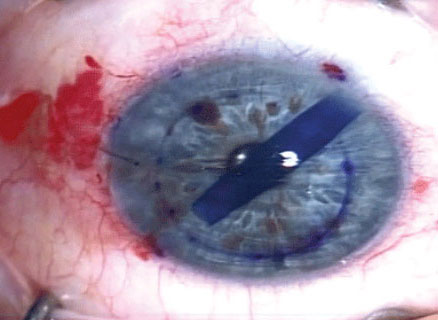 |
| IOP elevation may occur post-DMEK, but this study shows it is unlikely to affect visual outcomes. Photo: Aaron Bronner, OD. Click image to enlarge. |
There are known potentially serious complications of intraocular pressure (IOP) elevations after Descemet membrane endothelial keratoplasty (DMEK) surgery in glaucoma patients, but few studies have been done on non-glaucoma patients. In a recent investigation, researchers aimed to pinpoint the impact of IOP elevation after DMEK surgery in patients with no history of glaucoma.
A total of 164 patients were included. Group A included eyes without postoperative IOP increase, and group B included eyes with IOP elevation. The impact of elevated IOP within three days after DMEK surgery was evaluated in terms of best-corrected visual acuity (BCVA), central corneal thickness (CCT) and endothelial cell count (ECC) at one, three and six months.
An IOP increase post-DMEK occurred in 20 eyes (11.3% of all patients) in group B, which is comparable with previous study findings of IOP elevation after DMEK or Descemet stripping automated endothelial keratoplasty that ranged from 0% to 15.4%.
Decimal BCVA increased, whereas CCT and ECC decreased significantly from preoperative values in patients without (group A) and with (group B) IOP elevation, and there was no evidence for postoperative differences between both groups over a six-month follow-up. The rebubbling rate tended to be higher in group B.
“These findings coincide with previous studies reporting comparable BCVA and ECC values after IOP elevation post-endothelial keratoplasty in clinically more heterogeneous patient cohorts and provide further evidence that a promptly handled short-term rise in IOP after DMEK may not significantly affect the overall clinical outcome,” the study authors explained.
“When comparing rebubbling rates, our results indicated that patients with postoperative high IOP may be prone to be in need of a rebubbling procedure.”
A previous study suggested increased IOP impedes normal cell function and therefore permanent attachment of the graft.
“The fact that graft dehiscence occurred in group B in patients only after gas release also suggests that the reduced time of endotamponade or a significant IOP dip after gas release may have been the cause of rebubbling,” the authors suggested. “However, no rebubbling was required in eyes with postoperative transient subphysiologic IOP. Previous reports discussed that shortened endotamponade or IOP dips increase the risk of rebubbling. However, the total number of rebubbling procedures in our study was low, and this subject matter needs to be investigated in further studies with larger patient cohorts.”
Lentzsch AM, Adler W, Siebelmann S, et al. Impact of early intraocular pressure elevation on postoperative outcomes after Descemet membrane endothelial keratoplasty in non-glaucoma patients. Cornea. January 1, 2022. [Epub ahead of print]. |

